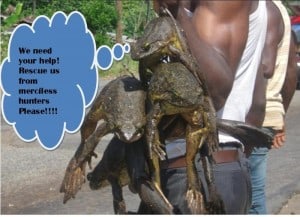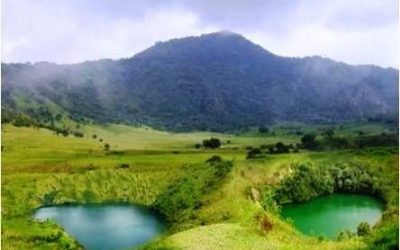
According to IUCN (International Union for Conservation of Nature), Goliath frogs is an endangered species because of a 50% decline in population size in the last three generations. Presently, the Goliath frog is teetering at the brink of extinction. All that is about to change as ERuDeF is set to launch a series of comprehensive scientific surveys in the forests where the amphibians live in the coastal part of Cameroon.
Working closely with local teams of rangers, we aim to learn more than ever about the Goliath frogs and the threats they face. With the knowledge gained, we will be able to devise and implement urgent measures for protecting the remaining Goliath frogs. It’s the only way we are going to save them from extinction.
The population of Goliath frogs in the wild is decreasing due to accelerated habitat loss (deforestation, hunting – their meat is a popular source of food for some African tribes – and over-collecting from the wild for pet trade).
The most important threat to this species is hunting for food, and new, sophisticated traps for catching this species are now being used in the Nkongsamba area of Cameroon. The amphibians are also exported from Cameroon to the USA on a regular basis by animal dealers for zoos, the pet trade and competitive frog races (one estimate of this trade is 300 animals per year). It is also adversely affected by the loss of forest habitat for agriculture, logging, and human settlements, as well as by sedimentation of their breeding streams. Measures are needed to work with local communities to manage the harvest at sustainable levels. A captive-breeding programme should be considered.
Since 1994, ERuDeF, a Cameroonian non-profit dedicated to the conservation of wildlife and protection of fragile environments through research, training, education and community engagement, has been active in conserving endangered primates, amphibians and plants in Cameroon. In 2014 we facilitated the creation of a protected area (Tofala Hill Wildlife Sanctuary) to conserve gorillas, chimpanzees, etc. However, the need for conservation remains high and continued efforts are needed to ensure the long-term survival of Goliath frogs in the region.
ERuDeF aims to work with local teams around Mt. Nlonako and carry out comprehensive scientific surveys in order to learn more about the Goliath frogs. The knowledge gained will enable us put comprehensive conservation plans in place. It will be a major step towards saving these endangered frogs from extinction. But we need your help to pay for it.
Will you help us raise the $8,260 needed to fund our crucial work?
ERuDeF’s presence to rescue amphibians and curb the illegal wildlife and pet trade is critical. Every Goliath frog rescued is important to the survival and continuation of the species. The only real hope for these amphibians is the preservation of their rainforest home. Those that cannot survive in the wild are given a life-long home. However, their offspring are candidates for future reintroduction into the wild.



